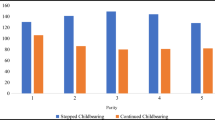Abstract
This article examines the conceptual claim that prenatal genetic testing, given the option to abort disabled fetuses, discriminates against the disabled. The claim is examined in the context of both external quality of life judgments and women’s competing interests in and right to reproductive freedom. The conceptual claim to discrimination fails in both contexts if moral standing is not attributed to the fetus.
Similar content being viewed by others
References
Dorothy C. Wertz and John C. Fletcher (1993) provide an extensive table summarizing several studies of selective abortion choices following prenatal testing for different countries. For example, 100% of women in Switzerland and 74–100% in the U.S. (studies varied) chose abortion for Down Syndrome fetuses. Termination was chosen for fetuses affected by metabolic disorders such as Tay Sachs disease, spina bifida, thalassemia, and hemophilia 100% of the time in at least one country. The rate of termination choice was lower but still significant for sickle cell anemia (39–54%), sex chromosome abnormalities (38–79%), cystic fibrosis (20–95%), and Huntington’s Disease (10–71%). “Feminist Criticism of Prenatal Diagnosis: A Response,” Clinical Obstetrics and Gynecology, Vol. 36, No. 3, Sept. 1993, pp. 554–56.
Down Syndrome is a congenital rather than a hereditary condition, though it is detected through chromosomal analysis. Risk may be identified prior to such analysis by maternal serum screening, chemical analysis of fetal gene product alpha-fetoprotein, and biochemical analytes such as human chorionic gonadotrophin.
Debra Sharu, “Attribution of Blame for A Child’s Disability,” Professional Nurse, Vol. 11, No. 12, Sept. 1996, p. 792.
This is the definition embraced by U.S. disability legislation.
This definition is based, in part, upon the definition provided by the National Institutes of Health’s Task Force on Genetic Testing. Holtzman, Neil A. and Watson, Michael S., Promoting Safe and Effective Genetic Testing in the United States: Final Report of the Task Force on Genetic Testing, London: Johns Hopkins University Press, 1998, p. 6.
Ibid.
As ultrasound may be a precursor to a genetic test, it is often considered a form of prenatal genetic “screening”. The technique does not involve assessment of biochemical or genetic material, however.
Allan Buchanan, “Choosing Who Will Be Disabled: Genetic Intervention and the Morality of Inclusion,” Social Philosophy and Policy, Vol. 13, 1996, p. 28.
Lynn Gillam, “Prenatal-Diagnosis and Discrimination Against the Disabled,” Journal of Medical Ethics, Vol. 25, 1999, p. 168.
Jonathan Glover states “if aborting the abnormal fetus can be followed by having another, normal one, then it will be wrong not to do this.” Causing Death and Saving Lives, Middlesex: Penguin 1977, p. 146. Glover presents one form of the “replaceability” argument. Replaceability has incited significant philosophical discussion. Most notably, it is also addressed, with slight contextual changes, by Derek Parfit in Reasons and Persons (1984), Clarendon Press: Oxford, 1984, Part Four, and Peter Singer in Practical Ethics, Cambridge; New York,2 1993, pp. 123–25, 129–31, 186–90. In an earlier work, Derek Parfit presents a famous hypothetical; a permutation of this hypothetical appears in Reasons and Persons, p. 367. A woman who wishes to become pregnant is told that if she waits three months, she may avoid a significant, incurable fetal disability. Parfit suggests that there is a moral imperative for the woman to avoid pregnancy for the few months. S. Gorovitz et. al. eds., “Rights, Interests, and Possible People,” Moral Problems in Medicine, Englewood Cliffs: New Jersey, 1976. Though replaceability is an important philosophical concept, such a discussion is inappropriate here. We are concerned only with whether replaceability in the PNGT context discriminates against the disabled, not with the philosophical strength of the concept.
Buchanan, op. cit., pp. 28ff.
Ibid.
Quoted in Christopher Newell, “A Critique of the Construction of Prenatal Diagnosis and Disability,” Ethical Issues in Prenatal Diagnosis and the Termination of Pregnancy, Monash University, 1994, p. 174.
Helen Houghton, “Does Prenatal Diagnosis Discriminate Against the Disabled? A Disabled Person’s Viewpoint,” Ethical Issues in Prenatal Diagnosis and the Termination of Pregnancy, Monash University, 1994, p. 98.
Presumably there are some disabilities which are so severe, that termination would not be concluded discriminatory, e.g. Tay Sachs disease where the child dies a painful death before five years of age. Termination may still be viewed morally problematic on other grounds, however, e.g. under the sanctity of life doctrine.
Gillam, op. cit., pp. 169
Ibid.
Buchanan, op. cit., 33–34.
S. Wiggins, et. al., “The Psychological Consequences of Predictive Testing for Huntington’s Disease: Canadian Collaborative Study of Predictive Testing,” New England Journal of Medicine, Vol. 327, No. 20, 1992, pp. 1404–405.
Reinders, op. cit., 3–10.
Undeniably, some impairments, e.g. severe spina bifida, may be so extensive that they would be considered disabilities regardless of social construction. Biological reductionism in this context in not morally problematic, however, because social changes or supports would fail to eliminate the disabilities.
Abby Lippman, “Prenatal Genetic Testing and Screening: Constructing Needs and Reinforcing Inequalities,” in Angus Clark, ed., Genetic Counselling: Practice and Principles, Routledge: London, 1994, pp. 149–52; Sharu, op. cit., pp. 790–92. This study indicates that 40% of surveyed nurses would attribute more blame to a women who refused PNGT and gave birth to a disabled child than to a woman who gave birth to a disabled child when PNGT was not available.
This situation poses the question of what constitutes adequate social supports. The answer to this query requires a valuing of capabilities and a theory of justice. Fortunately, however, we need not address these significant issues. The question we are asking is whether PNGT resulting in the abortion of disabled fetuses is discriminatory when it is consistent with broader societal discrimination against the disabled (whatever that discrimination may be).
Newell, op. cit., p. 174.
Author information
Authors and Affiliations
Rights and permissions
About this article
Cite this article
Satz, A.B. Prenatal genetic testing and discrimination against the disabled: A conceptual analysis. Monash Bioethics Review 18, 11–22 (1999). https://doi.org/10.1007/BF03351227
Published:
Issue Date:
DOI: https://doi.org/10.1007/BF03351227




